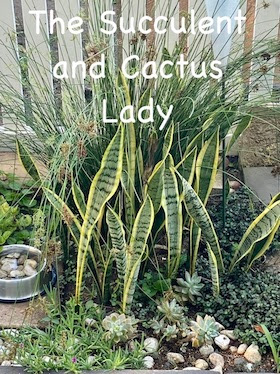About me

🌿 I've been gardening ever since a child, when I spent time with my father in his vegetable garden. But my fascination with Echeverias started in the 1980's, when my father gave me a pot with five Echeverias, which turned out to be E. imbricata. At first I wasn't much interested in them and planted them in some obscure corner of the garden and completely forgot about them. How great was my surprise when, a couple of months later, I noticed that they had spread and made a beautiful display - I was hooked!
Pages
Wednesday, 19 March 2014
Carpobrotus
I used to have stretches of this wonderful ground-cover in my last garden. This easy-to-grow succulent, native to South Africa, is a wonderful ground-cover, ideal for low-maintenance and water-wise gardens.
Leaves are eaten by tortoises. Puff-adders and other snakes such as the Cape Cobra are often found in Carpobrotus clumps where they ambush the small rodents that are attracted by the fruits. Flowers are pollinated by solitary bees, honey bees, carpenter bees and many beetle species. Flowers are eaten by antelopes and baboons. The clumps provide shelter for snails, lizards and skinks, so it’s a wonderful plant to have if you want to attract wildlife to your garden.
CARPOBROTUS C. acinaciformis (sour fig, elandsvy, goenavy, Hotnotsvy, strandvy, suurvy ) has purple flowers, robust, short, greyish green, sabre-shaped leaves and tasty edible fruits, used to make a delicious jam, and grows in coastal sands usually close to the sea, in the Western Cape, from Saldanha to Mossel Bay (South Africa).
Carpobrotus juice (from leaves) can be used as a mild astringent. When mixed with water the juice can be used to treat diarrhoea, dysentery and stomach cramps. It can also be used as a gargle for sore throat and laryngitis, and mild bacterial infections of the mouth. The leaf juice can also be used externally, much like Aloe Vera for burns, abrasions, open cuts, grazes, mosquito bites and sunburn. It is also used to treat ringworm, eczema, dermatitis, herpes, thrush, cold sores, cracked lips, chafing, skin conditions and allergies.
Info from Wikipedia
CONSERVATION STATUS
Carpobrotus edulis is not regarded as threatened in its native habitat, but it is invading natural areas in other parts of the world and threatening the survival of other species. In California, where it has been used since the early 1900s to stabilize the soil along railway tracks and roadsides and as a garden ornamental, it has naturalized and is invading coastal vegetation from north of Eureka to Rosarita Bay. It is known as the highway ice plant in the USA. It has naturalized along the west coast of Australia from Perth to Albany where it was also used for soil stabilization and is known as pigface. It has naturalized in parts of the Mediterranean and on the south coast of England.
.
Labels:
carpobrotus,
edulis,
flower,
flowers,
gauteng,
krugersdorp,
magaliesburg,
plants,
south africa,
succulent,
succulents,
suurvy,
tarlton,
vygie
Subscribe to:
Post Comments (Atom)





No comments:
Post a Comment